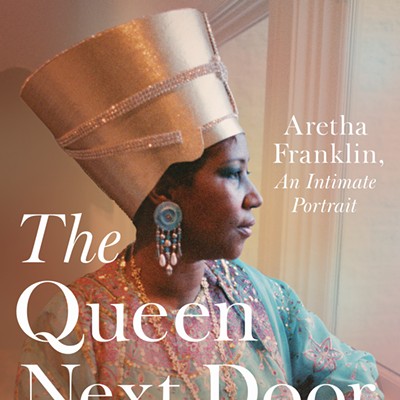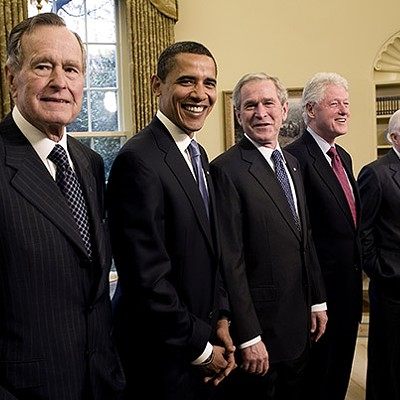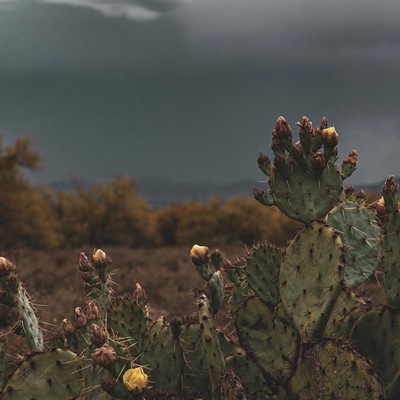Her punch line, repeated for several groups, was that this photographer with the strange name and even stranger aesthetic was born in a town in Illinois called Normal.
Meatyard's small photographs are anything but "normal," especially those evoking childhood. Back in the '50s and '60s, when his three children were young, the photographer would roam the Kentucky countryside, in search of the decaying houses so emblematic of the rural South. There, amid the rotting floorboards and peeling parlors, or in the dark woods out back, Meatyard would pose his fresh-faced kids in unsettling tableaux.
A boy leaps unexpectedly off a ledge in an untitled picture circa 1962-63, his body almost dissolving, like a ghost's. In another picture, one boy's face emerges out of the darkness underneath a splintering porch. Sometimes, the kids glare, or look puzzled, or grin. Though they're wholesomely dressed in striped T-shirts and jeans, the boys in all-American crew-cuts, the girl in blond curls, there's no trace of the usual sentiment about childhood. These are uneasy, ambiguous works. With the kids' youth contrasting with the ruin all around them, the pictures slide into allegory, photo-poems of innocence and experience. They hint at time passing, of life evolving into death.
Sometimes, Meatyard would pose the children in grotesque masks, and supply them with odd props like dolls or American flags. In one, a little boy sits in the corner of a room where forest-print wallpaper is peeling away from the wall; trash litters the floor. He holds a big, naked doll in his lap, and he obscures his face with an American flag. Strong stuff for 1959.
In "Romance (N) Ambrose Bierce #2," 1962--the compelling picture that gave this "Romance" series its name--Meatyard brought all three kids into the dark forest, scene of fairy-tale horrors. They wear terrifying masks. The younger boy, climbing up a little hill, has the mask of an old woman's face fastened to the back of his head, so that her face glowers behind him wherever he goes. The masked little girl, already on the summit, raises her arms up threateningly, her menace at odds with the sweet bloomers she's wearing. The older boy sits at the bottom, arms crossed, world-weary despite the toothy horror of his masked face.
Dark and enigmatic, gorgeously printed in rich blacks, grays and whites, these tiny staged dramas--most are just inches across--suggest a narrative just beyond our grasp. These pictures may be about these particular kids, but they're also about fleeting childhood itself, and the light and dark passages ahead. The late writer Guy Davenport, who selected the pictures for this traveling show, wrote of his friend's photos that they're like "short stories that have never been written."
Despite the startling work he produced, Meatyard lived a life that was "normal" by almost any measure. A family man who photographed mainly on weekends, he worked his whole adult life as an optometrist in Lexington. (He died of cancer in 1972, at 47.) Born in 1925, he apparently didn't pick up a camera until 1950; like any proud dad, he wanted to take pictures of his first baby, Michael. Even when he turned to art photography a couple of years later, he set up an ephemeral darkroom in his bedroom only once or twice a year, printing hundreds of images taken over the previous months.
But he didn't live in an artistic vacuum, either. He was a voracious reader who befriended numerous writers, including Davenport and the environmental writer Wendell Berry, both professors at the University of Kentucky, and Thomas Merton, the Trappist monk and poet. Sometimes he collaborated with them--Berry wrote an essay for Meatyard's book of Kentucky landscapes--and Meatyard in turn took their pictures. In one engaging portrait, included in the show, Merton merrily plays bongos in a book-lined study. Elsewhere, the monk joins Berry and poet Denise Levertov in the rolling Kentucky grasslands.
Meatyard also made links with cutting-edge photographers. He joined a Lexington camera club run by the influential Van Deren Coke, and studied in a summer workshop in 1956 with Aaron Siskind and Minor White. His early experiments betray some of these influences. "Untitled," 1955, is an off-kilter shot of a country sign that's advertising "Ky Country Ham's"; its diagonals slice against a pale gray sky, its near-abstraction of lines and letters recalling Siskind. The delicate "Zen Twigs" series, with single twigs twisting against plain backgrounds, borrow from White's ideas about the sacredness of art. And inspired by a painter friend, Fred Thursz, Meatyard experimented with pure abstractions of light on water, turning out dizzying zig-zags of light against dark.
But early on, Meatyard demonstrated his own predilections. A fine little untitled landscape from around 1955 unfurls a horizontal strip of Kentucky. The wintry trees of the rural landscape rise vertically in front of three ramshackle cabins, all of them about to rot back into the earth. In a picture from 1963, an old wooden house takes up almost the whole picture plane, bleeding out at the edges. A big black tree is off-center, a dark stroke running top to bottom, blocking out a full view of the front door. It's as unsettling, and as edgy, as the "Romance" pictures of kids.
Still, Meatyard really came into his own with the masked tableaux. As Cynthia Young, the curator who organized this traveling show for the International Center of Photography, put it, these pictures are "not so much surrealistic as transcendental." Yet from the vantage point of 2005, after Sally Mann has pictured her children in rural Virginia, after Emmet Gowin has elevated the family snapshot to high art, after Cindy Sherman has bedecked herself with every possible prop, it may be well nigh impossible to realize just how groundbreaking a photographer Meatyard was.
In any case, perhaps his strongest connections are less with photographers than with writers, particularly of the southern Gothic variety. A late series, "The Family Album of Lucybelle Carter," riffed on the Flannery O'Connor short story "The Life You Save May Be Your Own." The tale recounts how a mother pawns off her retarded daughter onto a flimflam man, who really only wants the family car. The man abandons Lucybelle, but Meatyard nevertheless pictures her imaginary life as a wife in a small Southern town.
The photographer's wife, Madelyn, plays Lucybelle, and takes her into the grotesque by wearing a hideous mask. Set up like snapshots, each of the witty pictures poses Lucybelle with fantasy family members or neighbors, her "15-year-old son" or her "bakerly brotherly friend," each wearing a mask of an old man's face. Despite the masks, all these pictures are fully loaded with the trappings of normal life. They're shot out by the laundry line or in tidy front yards; the people sit on a teeter-totter, or pose in front of red-brick houses.
Gone are the dark dilapidated wooden wrecks of the "Romance" series, and the deep forbidding woods. This is a small town in the brightness of day. In these pictures, among the last of his short career, Meatyard comes out into the light, illuminating the absurdity and tragedy of everyday life.














